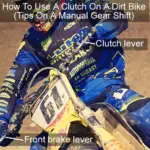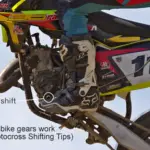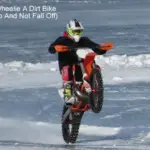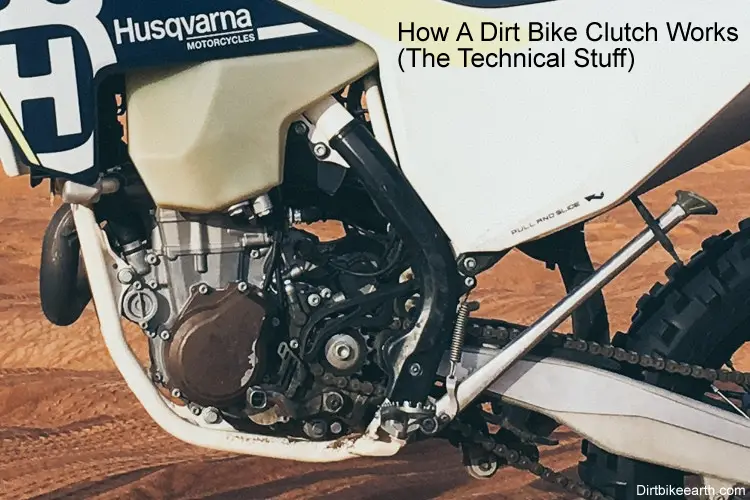
How the clutch works on your dirt bike; a beginners guide
Knowing how things work is sometimes beneficial to dirt bike riders. This can help your riding and preserving the life of your dirt bike. This article is about how a dirt bike clutch works.
The mechanics behind how a dirt bike clutch works are simple yet clever.
But in simple terms how a dirt bike clutch works: A clutch works on the principle of friction plates which are designed to slip and grip. These plates grip when the are compressed together by the clutch springs, but then slip when they are separated when the clutch lever is pulled in. The clutch is the mechanism that sits between the engine’s power and the gearbox.
The clutch either transfers power or disengages the power from the engine to the gearbox. Which then transfer the power to the chain and sprockets and then to the rear wheel. The clutch is essential for a dirt bike so it can come to a stop without stalling. And is used for gear changes.
Why a clutch is used in a dirt bike
If your dirt bike didn’t have a clutch and you came to a stop, the engine would stall. The engine needs to be disconnected from the rear wheel somehow. This is so the engine can remain running when you are stationary.
The alternative would be to switch the engine off each time you stopped. Or alternatively to buy a dirt bike with a semi-automatic or fully automatic transmission. How to use a clutch on a dirt bike is explained in this article on using a clutch and a manual gear shift.
What is a clutch and how does it work?
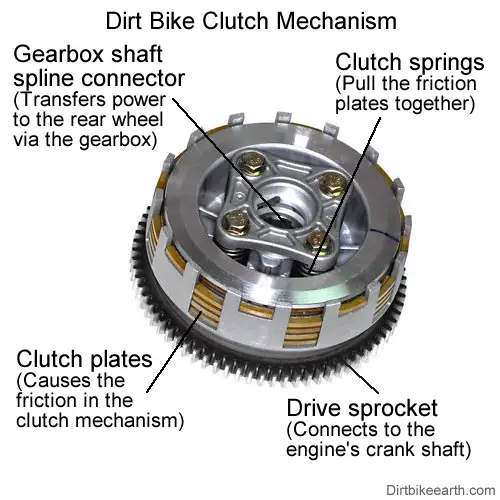
A clutch is a mechanical device which engages and disengages power transmission between the engine on a dirt bike and the gearbox.
A clutch works on the principle of connected friction plates. These plates allow for slippage so that the clutch can be engaged slowly to allow for a smooth pull away. If the connecting plates didn’t slip, the clutch would engage suddenly and your bike would lurch forward.
Friction plates are made from ceramics. Ceramics provide a high level of friction.
The clutch design
The clutch mechanism is a very clever yet simple design. Most clutches on dirt bikes are a drive friction clutch. There are springs which are designed to keep the clutch plates joined together when the clutch is released.
This is when there’s most friction between the plates. This is how the full power of the engine is transferred through to the central spline which is connected to the gearbox.
When this happens the drive from the engine is transferred directly through to the gearbox, which in turn is transmitted to the rear wheel. The power transfer to the rear wheel on a dirt bike is done via the chain and sprockets.
When the clutch is engaged, which is done by pulling the clutch lever on the left handle bar, the clutch plates are separated so that the engine’s power is disengaged from the gearbox.
The resistance you feel on the clutch lever when you pull this in is the clutch springs on the clutch mechanism.
To see the inside of a motorbike clutch, take a look at the video below:
Why it’s important to understand what a clutch is
Knowing how a clutch works and the mechanics behind it is useful for dirt bike riders. All parts of a dirt bike wear and need replacing at some stage. The clutch is a part that will wear out over time. So you should look after your clutch as much as you can.
Noting that the principle behind how a clutch works is plates slipping against one another, this should be born in mind when riding the clutch.
Riding the clutch is when you are holding the clutch in part the way so that the engine’s power is being transmitted to the rear wheel, but the clutch is partly only engaged and slipping. When this happens the clutch plates are slipping against each other and the surface of the plates will get hot and be worn down.
Some dirt bike riders ride the clutch by mistake as they ride along. This can happen by holding on to the clutch lever when riding. Riding the clutch will cause the slippage plates to get extremely hot and as a result will wear much quicker.
The friction between the plates constantly rubbing against the mental drive plates as they spin will increase the wear of the clutch plate. This will shorten the life your your clutch. So never sit with the clutch part way out with the engine revs high so that you can feel the engine biting, as this will cause long term damage to your clutch over time.
How to tell if your clutch is getting hot
If your clutch is getting hot due to slipping the clutch or riding the clutch, there’ll be a foul odor that is easily recognisable, The smell is similar to burning brake pads, as the clutch plate material is made of similar ceramic material to brake pads.
If you are able to smell your clutch burning, you are doing something wrong.
Knowing your clutch’s bite point is good when learning
But it’s good to get to know your dirt bike and the bite point of the clutch when you are beginning to learn.
But once you are familiar with your clutch and changing gears don’t be tempted to ride the clutch.
What happens when the clutch wears out
When the clutch slippage plates wear down, the clutch plates will no longer have enough frictional properties to keep the drive engaged through to the transmission. What happens as these clutch plates wear, is they will begin to slip against the metal drive plates, even when the clutch plates are fully engaged.
You’ll know if your clutch is slipping, as the engine revs will pickup higher than usual as you accelerate. You’ll get less power to the back wheel and your ride will not be a good one.
Another cause of clutch slippage is where the springs in the clutch mechanism lose some of their spring tension. Weak clutch springs are not able to hold the clutch plates together firmly enough, so slippage occurs.
One further cause for a slipping clutch is due to oil on the clutch plates. Oil can get onto the plates due to an oil leak from the engine. Clutch plates are designed to cause friction between the friction plate and the metal drive plates.
They are supposed to hold firmly against one another. But when you add oil into the mix, the friction is lost. Instead the clutch plates slip against the metal drive plates and cause the clutch to slip and not engage properly.
What to do if the clutch on your dirt bike is slipping
If you are suffering from a slipping clutch, it’s time to get a replacement clutch. If the slippage is due to an oil leak, the leak needs to be fixed first. You may be able to salvage the clutch after an oil leak. But if I were you, I would change it whilst the engine casing is off.
If you are mechanically minded and have the time, there’s no reason why you couldn’t change the clutch on your dirt bike yourself. But if you’re not mechanically minded or you don’t have the inclination to change the clutch yourself, you’ll need to book it in to a garage to fix it for you.
I hope you enjoyed this article about how a dirt bike clutch works
I’d love to hear from you. Tell us about your adventures of dirt biking in the comments below. Please also share your photos. Either from your cameras or videos from your Gopro’s!
If this article hasn’t answered all of your questions. If you have more questions about dirt biking (or specifically about how a dirt bike clutch works), please comment below with your questions.
There will also be many more articles about dirt biking for you to read and learn about this fabulous sport and hobby.
Have fun and be safe!
